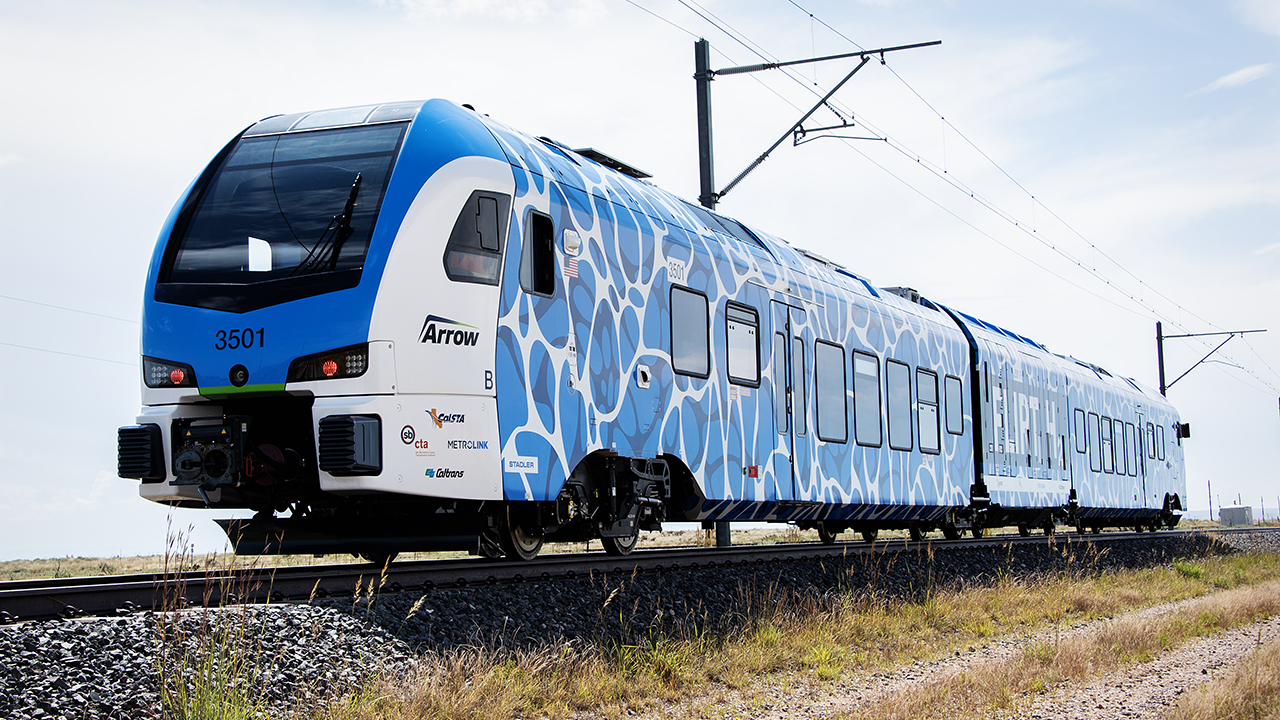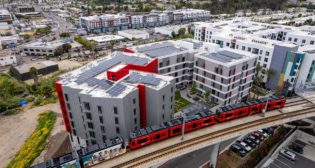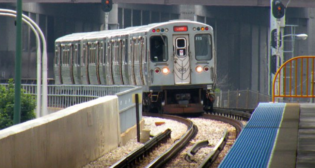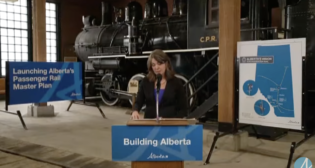
First U.S. Hydrogen Powered Passenger Trainset Testing at TTC
Written by Boris Nejikovsky, Special Advisor, and Matt DeGeorge, Senior Railway Research Engineer ENSCO, Inc.; and Lucy Andre, Chief of Staff, Stadler US Inc.
TTC OPERATED BY ENSCO, RAILWAY AGE OCTOBER 2023 ISSUE: Decreasing greenhouse gas emissions in transportation remains a topic of intense attention for the government, the industry and the public. According to the U.S. Environmental Protection Agency (EPA), the transportation sector is responsible for the largest share of greenhouse emissions in the country (28% in 2021). Other sectors (electrical power, industry, agriculture, commercial and residential buildings) each emit less. Although the transportation sector consumes less energy than the industrial sector, it generates more greenhouse gas (GHG) emissions due to its near complete dependence on petroleum fuels.
Hydrogen: A Promising Alternative Fuel
The U.S. government set a goal to achieve a 50-52% reduction in U.S. GHG emissions by 2030, and a net-zero economy by 2050. To achieve this goal, the transportation sector’s dependence on petroleum fuel must be decreased. One promising approach for rail transportation is the use of hydrogen fuel. In January 2023, the Department of Energy (DOE), Department of Transportation (DOT), EPA and Department of Housing and Urban Development (HUD) jointly released the U.S. National Blueprint for Transportation Decarbonization, which identified the strategic role of clean hydrogen in decreasing emissions. According to this blueprint, “Hydrogen offers a strong value proposition for applications requiring long driving ranges, fast fueling, and large or heavy payloads”—all typical characteristics of rail transportation.
Hydrogen is important for decreasing emissions because it is a very clean fuel. Hydrogen powered vehicles do not generate GHG emissions. If the hydrogen used is produced using renewable energy sources like solar and wind (so-called “green hydrogen”), GHG emissions are practically eliminated throughout the whole supply chain.
Hydrogen has other significant advantages as an energy carrier. It is very light and has the highest specific energy (energy content per unit of mass) of all common fuels. This is one reason why hydrogen is used as a fuel for many modern rocket engines. According to a DOE fuel properties comparison, 1 pound of hydrogen contains the same energy as 0.4 gallons (approximately 2.8 pounds) of diesel fuel. In practical applications, hydrogen requires high pressure or cryogenic storage tanks that somewhat decrease its advantage for smaller vehicles. However, the requirement for specialized storage tanks is easier to fulfill in larger and heavier machinery, such as railway vehicles.
Stadler ZEMU
Hydrogen-powered trains have been in service in Germany since 2018 and have completed trials in several other European countries. In 2019, Stadler US Inc. (a U.S. subsidiary of Swiss train manufacturer Stadler Rail) was awarded a contract from San Bernardino County Transportation Authority (SBCTA) to deliver the first-in-the-U.S. hydrogen-powered trainset with an option to order four more in the future. The train is called the ZEMU, for “Zero Emission Multiple Unit.”
The ZEMU uses a combination of hydrogen fuel cells and batteries for propulsion. Electrical power is created by combining hydrogen with oxygen in on-board fuel cells. The reaction between hydrogen and oxygen produces purified water and heat. When the ZEMU operates, it emits only water vapor, meaning cleaner air and less global warming. When the hydrogen itself is produced by green methods, the total system can achieve zero carbon emissions.
The ZEMU consists of two cars with a power module in between that holds the hydrogen tanks and fuel cells that generate electricity for the traction motors. The trainset has seating space for 108 passengers in addition to generous standing room, and can transport passengers with a maximum speed of up to 79 mph. It is expected to start operation as part of the Arrow service between San Bernardino and Redlands, Calif. in 2024.
ZEMU Testing at TTC
The first ZEMU train arrived in the U.S. in September and is being tested at the DOT Transportation Technology Center (TTC) in Pueblo, Colo. ZEMU tests are conducted by Stadler’s test engineers supported by ENSCO TTC personnel. The testing program consists of two phases. The first phase, taking place now, includes static lean, wheel load equalization and battery charging capacity tests.
The second phase consists of dynamic on-track tests required for train acceptance, including acceleration and deceleration, maximum speed, brake performance, EMI radiation, PTC and train radio, ride quality and other tests. The second phase will also include a set of tests specific for hydrogen powered propulsion, including verification of vehicle range, fuel consumption, propulsion performance, refueling operations and zero emissions verification.
Dynamic on-track tests of ZEMU will be conducted at TTC’s Transit Test Track (TTT) and/or the Railroad Test Track (RTT). The TTT is a 9.1-mile loop designed to simulate urban rail settings, including tight-turn curves. The RTT is a 13.5-mile loop for testing trains in a broad range of speeds up to 165 mph. Both tracks provide great flexibility in terms of train movements and allow Stadler and ENSCO test engineers to evaluate various operational scenarios.
TTC Support for Hydrogen Fueled Trains
Both Stadler and ENSCO have paid particular attention to proper fueling operation and fuel storage at TTC. ENSCO has established a roadmap with support of our partners that includes a short-term solution and a longer-term plan to establish a permanent hydrogen fueling station and to conduct hydrogen transportation research and testing at TTC.
The North American railway industry needs alternative green energy sources, such as hydrogen trains to meet increasing sustainability requirements. The TTC is proud to support the first U.S. hydrogen passenger train testing and is ready to support all future research and testing needs to enable a safe and sustainable transportation future.
Industry professionals got a first peek at the Stadler ZEMU at APTA EXPO in Orlando, Fla., where Stadler presented the vehicle for the first time in the U.S. Further, the Stadler ZEMU is scheduled to return to TTC by Nov. 7.
Be sure to check out the TTC First Annual Conference & Tour Nov. 7-8 to learn more about the TTC’s role to support future transportation. More information can be found at https://ttc-conference.com/.




